Austrian Orders, Decorations and Medals of the Napoleonic Period
by Stephen Herold
Orders
Most of the orders of Austria, and of other states as well, were in three classes,
usually grand cross, commander and knight. The grand cross and commander insignia
were usually worn around the neck on the ribbon of the order, and the knights
wore theirs on the left breast hanging from the ribbon of the order. Later, grand
cross insignia were worn hanging from a ribbon of the order worn diagonally across
the chest. Starting around this time, and becoming general practice by 1848 or
so, was the folding of the knights' ribbon into a triangular or "dreiecks" shape.
It was peculiarly Austrian but also copied by many other countries who were Austria's
neighbors or under her cultural or military influence. Knights grand cross, and
often commanders as well, wore a breast star of the order on both ordinary and
formal occasions -- with the sash for formal events and alone on the jacket or
unform otherwise. On special occassions the Knights Grand Cross wore the collar
of the order, and for ceremonies of the Order robes, hats and other special items
as well. In later times miniatures were worn in everyday use, hanging not from
a ribbon of the order but from a chain that was a minature collar of the order.
In addition to being worn as a full size "bijou" and miniature, the Order of the
Golden Fleece was worn in German lands as a "knopfloch" buttonhole insignia of
the Fleece only with a red ribbon, sometimes full size and sometimes around half
size
Although the awarding of orders of knighthood in Europe was traditionally only
to members of the nobility, the growth of modern states with larger armies and
bureaucracies was requiring a relaxation of the ancient restrictions. Elsewhere,
as in Britain, the awarding of the order could elevate one to the nobility as
a part of the reward. Similarly, further merit could be rewarded by the granting
of a higher grade of the order. In ultra conservative Austria such liberties were
seldom seen. Not only did a recipient have to already be a noble to receive an
order, but the grade of the order one received was based on the rank of their
nobility. This reinforced the ancient elitist structure of the Austrian Empire
but completely failed to provide adequate rewards for the mass of he Empire's
subjects. Even in such small things we can see the seeds of the collapse of of
the Austrian polyglot medieval monarchy in the face of modern realities.
The Order of the Golden Fleece
 Ancient and inherited from the dukes
of Burgundy who founded it on 10 January 1429. Awarded only to the Imperial family
and the highest of the nobility in Austria and abroad. One had to be Catholic
and of good character to receive it. Except for Imperial archdukes and foreign
nobility it was usually only given late in life as a reward for a lifetime of
service to the Imperial family.
Ancient and inherited from the dukes
of Burgundy who founded it on 10 January 1429. Awarded only to the Imperial family
and the highest of the nobility in Austria and abroad. One had to be Catholic
and of good character to receive it. Except for Imperial archdukes and foreign
nobility it was usually only given late in life as a reward for a lifetime of
service to the Imperial family.

Ribbon: Red.
Grades: One only, as in all ancient orders of knighthood.
Also see The Society of the Golden Fleece.
The Military Order of Maria Theresa
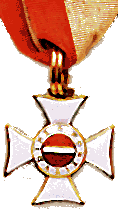 Founded by the Empress Maria
Theresa on 22 June 1757 as a reward for merit for senior military officers. The
order was to be granted as a reward for acts of military valor and to perpetuate
the memory of the brave officers receiving it. An officer had to command in a
battle or a unit in a winning action to be eligible for the higher grades, and
even Oberlieutenants had to perform prodigious feats of duty and valor to receive
the knight's cross. Not often awarded in the Austrian army. As with many high
orders the decoration was to be returned to the Chancellery of the Order on the
death of the holder. This is one reason for its great rarity, especially of older
issues. Almost all known copies in commerce are 20th century, most from the First
World War or insignia made for holders of the Order after the end of the war.
Founded by the Empress Maria
Theresa on 22 June 1757 as a reward for merit for senior military officers. The
order was to be granted as a reward for acts of military valor and to perpetuate
the memory of the brave officers receiving it. An officer had to command in a
battle or a unit in a winning action to be eligible for the higher grades, and
even Oberlieutenants had to perform prodigious feats of duty and valor to receive
the knight's cross. Not often awarded in the Austrian army. As with many high
orders the decoration was to be returned to the Chancellery of the Order on the
death of the holder. This is one reason for its great rarity, especially of older
issues. Almost all known copies in commerce are 20th century, most from the First
World War or insignia made for holders of the Order after the end of the war.

Ribbon: Equal stripes of red, white and red.
Grades: Three: Knights Grand Cross, Knights Commander and Knights
See also the Medal of Honor for the battle of Villiers-en-Couche in1794 listed
below.
The Royal Hungarian Order of St. Stephen
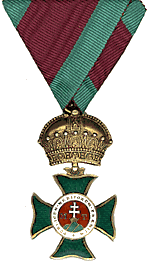 Established by the Empress
Maria Theresa on 5 May 1764 to reward her noble Hungarian subjects for civil merit.
To receive it one had to have at least four quarterings of arms showing as many
generations of noble status. It helped promote her position as Queen of Hungary
and reinforced the quasi independent position of Hungary in the Empire. The original
statutes allow for only 20 Grand Crosses, 30 Commanders and 50 Knights who are
to be "distinguished for virtue and merit and noble birth". Grand Cross Knights
were considered so important that the Emperor was to address them as "Cousin".
These insignia were to be returned to the Chancellery of the Order on the death
of the holder. There was no military application of this order. It is rare, and
even modern awards of St. Stephen are seldom seen. Perhaps more than any other
Austrian order, this one approached the ideal character as put forth in its statutes
and regulations.
Established by the Empress
Maria Theresa on 5 May 1764 to reward her noble Hungarian subjects for civil merit.
To receive it one had to have at least four quarterings of arms showing as many
generations of noble status. It helped promote her position as Queen of Hungary
and reinforced the quasi independent position of Hungary in the Empire. The original
statutes allow for only 20 Grand Crosses, 30 Commanders and 50 Knights who are
to be "distinguished for virtue and merit and noble birth". Grand Cross Knights
were considered so important that the Emperor was to address them as "Cousin".
These insignia were to be returned to the Chancellery of the Order on the death
of the holder. There was no military application of this order. It is rare, and
even modern awards of St. Stephen are seldom seen. Perhaps more than any other
Austrian order, this one approached the ideal character as put forth in its statutes
and regulations.

Ribbon: Violet with two smaller dark green side stripes.
Grades: Three: Knight Grand Cross, Knight Commander and Knight.
The Austrian Imperial Leopold Order
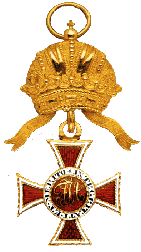 Established by Emperor
Francis I on 8 January 1808 in honor of his father, and to provide the Empire
with an order that could be used to reward noble subjects for service to the Emperor
and the State. The existing senior orders before 1808 were too limited in their
scope to permit rewarding sufficient subjects for their duty. The choice of Leopold
for this order's name is not too strange, since he was Francis' father, but he
is also the most shadowy of the modern emperors with his brief two year reign.
The Knights Grand Cross were also addressed by the Emperor (as Grand Master of
the Order) as "Cousin" as with Grand Cross members of the St. Stephen Order. Collars
and insignia were returnable upon death of the member, the collar to the Grand
Master and the insignia to the Registar.
Established by Emperor
Francis I on 8 January 1808 in honor of his father, and to provide the Empire
with an order that could be used to reward noble subjects for service to the Emperor
and the State. The existing senior orders before 1808 were too limited in their
scope to permit rewarding sufficient subjects for their duty. The choice of Leopold
for this order's name is not too strange, since he was Francis' father, but he
is also the most shadowy of the modern emperors with his brief two year reign.
The Knights Grand Cross were also addressed by the Emperor (as Grand Master of
the Order) as "Cousin" as with Grand Cross members of the St. Stephen Order. Collars
and insignia were returnable upon death of the member, the collar to the Grand
Master and the insignia to the Registar.

Ribbon: Red with two thin white edge stripes.
Grades: Three: Knight Grand Cross, Knight Commander and Knight Ordinary.
The Austrian Order of the Iron Crown
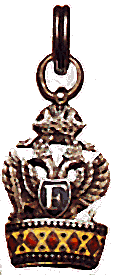 When Austria resumed control
of Northern Italy in 1815 she continued the Coronne de Fer as an Austrian order.
The Austrian order was founded by decree of 1 January 1816. All existing noble
members were eligible, but non-nobile members had to accept the Military Service
Medal "Pro Virtute Militari" (listed below).
When Austria resumed control
of Northern Italy in 1815 she continued the Coronne de Fer as an Austrian order.
The Austrian order was founded by decree of 1 January 1816. All existing noble
members were eligible, but non-nobile members had to accept the Military Service
Medal "Pro Virtute Militari" (listed below).
In the first issue it was given in gold to ex-dignitaries and ex-grand dignitaries
and silver to knights, as in Napoleon's Coronne de Fer. Soon thereafter given
in gold only (later silver gilt and finally bronze gilt). The early pieces had
as much variation and irregularity as the French issue, but the order soon settled
on the pattern of a slender eagle with both legs clearly showing above the Iron
Crown. After 1860 the eagle's legs are smaller and the tail is placed mostly within
the Iron Crown. On 12 January, 1860 the use of War Decorations ("Kriegs Decoration"
or KD) was authorized for awards made during wartime. Originally there were to
be only 100 members: 20 First Class, 30 Second and 50 Third (with "Princes of
Our Imperial House not included in this number"), but the number was later greatly
increased. The Knight's decorations of the Order were returnable upon death up
to July 18, 1884, after which date they could be retained, but the higher classes
of the Order were always to be returned.
Until the end of the Empire this was the most commonly awarded Austrian order.
During the later part of the First World War it even turned into an officer's
bravery medal that could be awarded more than once. With the loss of her Italian
territories in the wars of 1859-70 Austria had little need for the Iron Crown
as an Italian symbol and it became an "all purpose" order. In design, many find
the order one of the most attactive of all the orders of Europe. Interestingly,
the crown shown on the Coronne de Fer, Austrian Order of the Iron Crown and the
Royal Italian Order of the Crown is the crown of Queen Theodolinda, not the Iron
Crown of Lombardy as intended.

Ribbon: Golden yellow with two thinner blue stripes at the edges.
Grades: First,second and third classe knights (following Napoleon's three
grades of Grand Dignitary, Dignitary and Knight). The insignia of the three grades
were in descending size matching the grade of the member.
Medals
All of the medals issued during this period -- 1792-1815 -- were during the reign
of Emperor Francis I (II). Just as Napoleon was the leader of France throughout,
so Francis was the guiding spirit of Austrian policy and architect of her ultimate
patient victory. It is also under Francis that there was a sudden increase in
the number of medals awarded to his subjects. The prolonged importance of the
wars and alliances was mirrored in the medals issued for duty and merit. Many
are for the daring experiment of citizen militias, an experience so tainted by
association with the citizen armies of the French revolution that it was quickly
suppressed and not soon repeated.
Reward Medal of 1792 for Services to the Austrian Army in Belgium
Founded by Emperor Francis II to reward Dutch citizens who joined or rendered
good service to the Austrian army fighting the French Republic. Issued in silver
and gold as an eight sided medal with ball and ring suspension.

Ribbon: Red.
Size: 33 mm
Obverse: head of the Emperor facing right with a circumference inscription:
"FRANCOIS II. IMP DES ROM ROI DE HONG ET DE BOH" .
Reverse:Inside a laurel wreath, tied at the stem, are six lines of type:
"POVR / SERVICES / RENDVES / AUX / ARMEES / MDCCXCII".
Belgium Reward Medal Reissue for 1793-94
The medal was reissued in 1793 in gold, and 1794 in gold and silver. They only
differ from the item above in the changed date. In 1793 four gold medals were
awarded, and in 1794 six gold and 20 silver.
Honor Medal "LEGE ET FIDE" of 1792
Founded by the Emperor on the occasion of his coronation as German Emperor at
Frankfort am den Main. Issued as large, medium and small gold and large and small
silver medals. However, none of the small silver medals has ever been found. (The
official Austrain statutes frequently mention medal size distinctions that were
never issued.) It was given to members of the Emperor's suite according to their
rank. The large gold medal could be awarded with a linked mail chain of gold of
the weight of the medal as an extra honor. Many Austrian medals could be so awarded
with an extra gold chain suspension. Normally suspended from a soldered ring.
A variation with the Bohemian lion on the reverse may have been issued for the
Bohemian coronation of Francis (v. Heyden 1058-9).

Ribbon: Red.
Size: Large, 49 mm; medium 43 mm; small 36 mm.
Obverse: Head of Francis II facing right with a laurel wreath in his hair.
Circumference inscription: "IMP. CAES. FRANCICVS. II P. FG. AUG.". Signed by the
designer at the base "I. N. WIRT. F.".
Reverse: An Imperial Crown above crossed scepter, sword and orb. At the
top: "LEGE ET FIDE".
Honor Medal for Bravery 1792-1805
Like the bravery medal of Joseph II of 1789-92, but bearing the head of Francis
II, and awarded in gold and silver.

Ribbon: White side stripes (5 mm), rose stripes (5 mm) separated by a central
white and rose ladder stripe pattern (1 mm stripes) -- that came to be known as
the "bravery ribbon". The rose color later became red.
Size: 40 mm
Obverse: Head of Francis II, crowned with laurel, facing right. Above "FRANZ
II" and underneath the designers name "I.N. WIRT. F.".
Reverse: A tied laurel wreath with flags showing Austrian arms, within
the wreath is the inscription "DER / TAPFERKEIT".
Medal for the Battle of Neerwinden, 1793
Issued in silver by the Prince Friederich Josaias of Saxe-Coberg, the Imperial
fieldmarshall in Belgium. The medal was granted by Francis II after the defeat
of the French under General Dumouriez on 18 March 1793. Suspension was by a soldered
ring.

Ribbon: Red.
Size: 47mm
Obverse: Bust of Prince friederich facing right with a circumference inscription:
"FRIDERIC. JOSIAS. PINC. SAXO. COB. S. R. J. SUPR. BELLI. DUX." . At the bottom
is "Baldenbach", the die cutter's name.
Reverse: Roman soldiers in a ritual scene with the circumferance inscription:
"RESTUTITORI. BELGII. AUSPICE. AUGUSTO." above, and below on three lines and smaller:
"GALLIS MENSE. MARTIO / MDCCXCIII. UTROQUE / BELGIO EXATIS." .
Medal of Honor for the battle of Villiers-en-Couche, 1794
Issued in gold by Francis II to eight English officers of the Fifteenth Light
Dragoons who personally attended and protected him during the battle of Villiers-en-Couche
on 24 April 1794. The medals, although not officially established by written proclamation,
were given with a letter of praise on 1 May 1798. All of the medals were also
given with a golden chain of equal weight (280 grams). By some accounts the dragoons
saved Francis from capture by the French. The Emperor wished to give them the
Military Order of Maria Theresa, but the regulations of the order made that impossible.
Later the regulations of the Order were changed and the MMTO was awarded to several
Russians. The British government made repeated requests to obtain the MMTO for
the dragoon officers, and it was finally granted on 7 November 1800. The medal
was no longer to be worn once the MMTO was awarded, but could be kept.
Only one genuine pair of awards is known, which was in the collection of Mr. E.
Hyde Greg of London as early as 1897. The pair was sold by Spink & Son in
1966 when it was purchased by Dr. Fattovich of Venice, Italy. The medal is unnamed
as issued. (This interesting information is from von Falkenstien.)
Size: 60 mm
Obverse: Head of Francis with a laurel wreath facing right. Circumference
inscription: "IMP. CAES. FRANCISCUS. II. P. F. AUG." . Signed by die cutter below
and very small: "I. N. WIRT. F." .
Reverse: Above small crossed laurels on four lines: "FORTI. BRITANNO. /
IN. EXERCITV. FOED. / AD CAMERACVM. / XXIV. APR. MDCCXCIV." .
Tyrolian Mobilization Medal of 1796
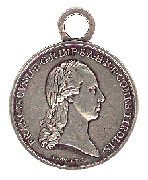
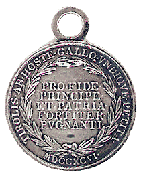
Issued by Emperor Francis to all Tyrolians who took up arms in the mobilization
call of 12 August 1796. Given in large silver to officers and small silver to
non-commissioned officers and soldiers. The ribbon is hung through a flat ring
eye.

Ribbon: Multicolored green, white, black and red.
Size: Large, 40 mm; small 35 mm.
Obverse: Porfile head of Emperor Francis with a laurel wreath facing right.
Circumference inscription: "FRANCISCVS. II. D. G. R. IMP. S. A. H. B. R. COMES.
TYROLIS." with the smaller designers name below: "I. N. WIRT. F." .
Reverse: Circular laurel wreath, tied at the bottom. Inside the inscription:
"PRO. FIDE. / PRINCIPE. / ET. / FORTITER. / PUGNANTI." (To the heroic fighter
for faith, prince and country). Around the circumference: "TIROLIS. AB. HOSTE.
GALLO. VNDIQUE. PETITA." on the top, and below: "MDCCXCIV.".
Medal for the Volunteers of Olmutz, 1796
Given by the civil board of the town of Olmutz to those who volunteered in the
mobilization call of 12 August 1796 and formed a fully armed volunteer corps for
service with the Emperor. Issued in gold plated silver, hung through a circular
ring soldered on at right angles to the medal.

Ribbon: Yellow with black edges.
Size: 45 mm
Obverse: The laurel crowned head of the Emperor facing right. Beneath the
bust is: "F II / R. I. S. A." (Franciscus II Rex Imperator Semper Augustus), and
around the circumference inside a pearled border: "Milito Electo Caesarem et Patriam
Defendenti".
Reverse: The checkered eagle of the town arms, and on its breast shield
"FMT". Around the circumference: "SENATUS POPULUSQUE OLOMUCENSIS Ao: 1796" within
a pearled edge.
Tyrolian Mobilization Medal of 1797
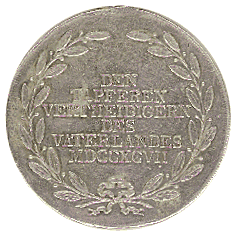 Founded by Emperor Francis
in 1797 for those members of the Tyrolian volunteer contingent who served in the
keeping the Tyrol free from the French army. Given in large gold, for highest
officers, gold for officers and silver for soldiers. The large gold are very rare
and the gold ones rare. Suspended from a ribbon through a circular eye. The silver
medal is much commoner than that of 1796 so many more Tyrolians must have responded
to the mobilization call.
Founded by Emperor Francis
in 1797 for those members of the Tyrolian volunteer contingent who served in the
keeping the Tyrol free from the French army. Given in large gold, for highest
officers, gold for officers and silver for soldiers. The large gold are very rare
and the gold ones rare. Suspended from a ribbon through a circular eye. The silver
medal is much commoner than that of 1796 so many more Tyrolians must have responded
to the mobilization call.

Ribbon: Three black and two gold equal stripes with thin gold edging.
Size: Large gold and silver, 39 mm; small gold 35mm.
Obverse: Profile bust of Francis wearing a laurel wreath and facing right.
Circumference inscription: "FRANZ II R. K. ERZH. ZU OEST. GEG. GRAF VON TYROL",
and below and smaller the designers name "I. N. WIRT. F.".
Reverse: Within a laurel wreath tied at the bottom, on six lines: "DEN
/ TAPFERN VERTHEIDIGERN / DES / VATERLANDS / MDCCXCVII".
Lower Austrian Mobilization Medal of 1797
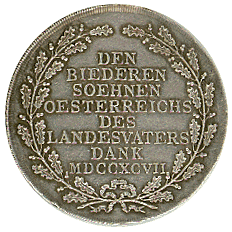 Given to those able bodied
men who answered the national emergency mobilization call of Count Saurau in Lower
Austria. These troops were formed into free corps called Landesstande. The medal
was, on paper, awarded in five types: gold for highest officers, largest silver
for officers, large silver for underofficers, silver for soldiers and black cast
iron for non-combattants. The iron medal has never been seen and the soldier's
silver medal is also unknown and probably not issued. The gold medal, given to
Count Saurau, the Duke of Wurttemburg (as commander of the troops) and high district
and government officials is very rare. Almost all medals known are the largest
and the large silver. Suspended by a ribbon from a circular eye.
Given to those able bodied
men who answered the national emergency mobilization call of Count Saurau in Lower
Austria. These troops were formed into free corps called Landesstande. The medal
was, on paper, awarded in five types: gold for highest officers, largest silver
for officers, large silver for underofficers, silver for soldiers and black cast
iron for non-combattants. The iron medal has never been seen and the soldier's
silver medal is also unknown and probably not issued. The gold medal, given to
Count Saurau, the Duke of Wurttemburg (as commander of the troops) and high district
and government officials is very rare. Almost all medals known are the largest
and the large silver. Suspended by a ribbon from a circular eye.

Ribbon: Half dark rose half white.
Size: Gold and silver 37 mm, largest silver 41 mm, Large silver and black
iron 39mm.
Obverse: Bust of Francis wearing a laurel wreath and facing right. Circumference
inscription: "FRANZ II. ROM. KAI. ERZHERZOG ZU OESTERREICH" and smaller on the
bottom edge: "I. N. WIRT. F.".
Reverse: Within an oak wreath tied at the bottom, on eight lines: "DEN
/ BIEDEREN / SOEHNEN / OESTERREICHS / DES / LANESVATERS / DANK / MDCCXCVII".
The Ecclesiastical Cross of Merit "Pius Meritus"
Austrian military chaplains were active during campaigns and frequently awarded
the Honor Medals for bravery. At the suggestion of the Apostolic Field Vicar Count
Hohenwerth, and supported by a report of Archduke Charles, the ecclesiastical
cross of merit was established in 1801 by Emperor Francis. Initially given in
two grades -- gold and silver -- with a third added in 1860. It was to be given
for outstanding performance of duty in administering to the spiritual requirements
of the troops during war when under fire or in a battle area.
More like an order than a medal, the crosses had cloverleaf ends on the arms and
the bottom arm was longer. The arms had a deep cut border and a flat suspension
eye soldered onto the top. The central medallion in blue enamel had the words
"PIIS / MERITIS" on two lines.

Ribbon: Four white and three red stripes.
Size: 53 mm high, 44 mm wide, 20 mm center medallion.
Dalmatian Service Medal of 1801
Founded by Francis in 1801 for administrative and civil merit in the Kingdom of
Dalmatia which had been awarded Austria by the Peace of Campo Formio. Issued in
silver and suspended from a ribbon through a soldered eye.

Ribbon: Red.
Size: 43 mm.
Obverse: Laurel crowned bust of Francis facing right. Circumference inscription:
"FRANCISCVS. II. ROM. IMP. DALMATIE. REX.". Below, in smaller letters: "I. N.
WIRT. F.".
Reverse" In two lines: "DALAMTIAE / BENEMERENTI", and smaller at the bottom
"MDCCCI".
Civil Medal of Honor "JUSTITIA . . ." 1804-35
Founded on 11 August 1804 along with the next item (Honor Medal "Honori") following
the change in Francis' title from German Emperor to Austrian Emperor. This medal
was for persons without special rank (i.e. lower ranking non-nobles) and was largely
given for service at the court. Suspended by a ribbon from a coined, vertically
holed and tailed eye with a large circular ribbon ring. Issued in large gold,
gold, large silver and silver.

Ribbon: Red.
Size: Large 43 mm, small 36 mm.
Obverse: Bust of Francis in profile, crowned with a laurel wreath and facing
right. Circumference inscription: "FRANCISCVS AVST. IMP. HVN. BOH. GAL. LOD. REX.
A. A.", but on the small medals FRANCISCVS is shortened to "FRANC.". On the bottom
and smaller is "I. N. WIRT. F.".
Reverse: Under an Imperial Crown a crossed sceptre and staff of Mercury
with the scales of justice below. All connected by a flowing ribbon in a bow.
Around the upper circumference: "IVSTITIA REGNORVM FVNDAMENTORVM" (Justice is
the foundation of the Empire).
Civil Medal of Honor "HONORI" 1804-13
Founded by Emperor francis soon after he became Emperor of Austria so that non-nobles
who could not receive the Imperial orders could be rewarded for their service.
Issued in gold and silver and the gold medal could be awarded with a gold chain
of the weight of the medal. One of the best known recipients of this medal, in
gold with the chain, was Andreas Hofer who led the Tyrol revolt of 1809 against
the French and Bavarians. Whereas the Honor Medal "JUSTITIA" was primarily awarded
to members of the Emperor's entourage, this medal was for more general presentation.

Ribbon: Red.
Size: 50 mm.
Obverse: Profile bust of the Emperor with laurel wreath facing right. Circumference
inscription: "FRANCISCVS AVSTRIAE IMPERATOR", and smaller at the bottom "I. N.
Wirt. F.".
Reverse: A classic temple with six columns, with an enthroned Austrian
coat of arms in the middle. On a rectangular box on the temple plinth is found
"HONORI". Around the top is the circumference inscription: "AVSTRIA AD IMPERII
DIGNITATUM EVECTA", and across the bottom is the date. Von Falkenstein states
that the date is "1813", but since the medal was given from 1804 that seems very
unlikely. Just how often the date was changed is unknown.
Medal for the Country's Defenders of 1808
This is a medal with many questions still unanswered, including why it was given.
One theory is that it was for the 10th anniversary of Francis' Hungarian coronation
on 6 June 1808. Given in silver and often with no suspension, as if a display
medal not intended for wearing.
Ribbon: Unknown, if any.
Size: 50 mm.
Obverse: Head in profile of Francis and Empress M. Louise Beatrix (daughter
of Archduke Ferdinand of Austria, Duke of Modena-Breisgau, and third wife of Francis).
The Emperor's head is in front and largely covering that of his wife. Beneath
their busts are small laurel branches and the initials "ST" of Stuckhart, the
die cutter, working in Prague in 1796 and Vienna 1801-1816.
Reverse: Two wreaths of oak leaves tied at the base. Around the top is
the cirumference inscription: "SEINEM VERTHEIDIGER DAS DANKBAR VATERLAND" (To
its defenders -- The thankful country) and below the wreath, on two lines "6 JUNE
/ 1808". At the very bottom and quite small is the engraver's name "A GUILLEMARD
F.".
Medal for the Tyrol and Voralburg Defenders of 1809
Issued for service in the Tyrol by volunteer citizens in 1809. Issued in bronze.

Ribbon: Half green and half white.
Size: 49 mm.
Obverse" Within a laurel wreath on seven lines: "ZUM / ANDENKEN / DER TYROL
UND / VORALBERGER / LAND- / VERTHEIDIGER / 1809" (In memory the Tyrol and Voralberg
land defenders 1809).
Reverse: On the left, Andreas Hofer, his left hand on the Austrian flag
and his right hand raised as in oath taking. Opposite him a Tyrolian and Voralberger
in local costume with their right hands raised . At the bottom the small inscription
"O. STEINBOCK INV. ET F.".
Bravery Medal of Francis I of 1809
With the change in 1805 of the Emperor's title from Francis II of Germany to Francis
I of Austria new medals were required. Seemingly only issued for the war of 1809
(until 16 October 1809). No changes from the 1792 issue except for the obverse
inscription. Regulations were also changed to prohibit continued wearing of the
silver medal if the gold was also won. Issued in gold and silver.

Ribbon: Rose edge stripes with a white and rose ladder center.
Obverse: Head of Francis II, crowned with laurel, facing right. Above around
the circumference "FRANZ KAISER VON OESTERREICH" and underneath the designers
name "I.N. WIRT. F.".
Reverse: A tied laurel wreath with flags showing Austrian arms, within
the wreath is the inscription "DER / TAPFERKEIT".
Bravery Medal of Francis I of 1812-14
Identical to the bravery medal of 1809 except for a coined on oval suspension
loop and a new designer's name on the lower obverse: "I, HARNISCH. F.". Given
for service in Russia in 1812, Germany in 1813-14 and Italy in 1815. Two die types
are known.
Civil Honor Medal "Honori" 1813-1835
As with the issue of 1804-1813, but the die engraver was Heuberger rather than
Wirt. The only changes were to the inscription on the obverse. The new circumference
inscription reads: "FRANC. I. AUST. IMP. HVN. BOH. LOMB. ET. VEN. GAL. LOD. IL.
REX. A. A." and at the bottom "HEUBERGER" (missing the usual "F." for "fecit"
or "I made this").
Bronze Canon Cross of 1813-14
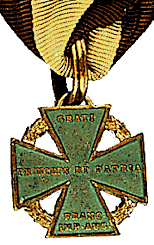 Authorized by Emperor
Francis in 1814 for award to his soldiers in memory of their participation in
the Befreiungskrieg of 1813-14 to free Germany and Europe from the domination
of Napoleon. It was not actually awarded until 1815. Usually called the "Canon
Cross" because it was made from captured bronze canon, and sometimes wrongly called
the "Leipzig Cross" after that decisive battle in 1813. It is significant in that
it is the first award given equally to all serving soldiers irrespective of rank.
There originally were plans for three sizes of cross, and some specimens do exist,
but in the end only one type, the small bronze with green varnish background,
was made and distributed. One large gilded cross with a laurel leaf decorated
wearing ring was made for FM. Prince Schwarzenberg as commander in chief, and
it was intended to be worn from a ribbon around the neck. This unique piece is
in the Army Museum in Vienna.
Authorized by Emperor
Francis in 1814 for award to his soldiers in memory of their participation in
the Befreiungskrieg of 1813-14 to free Germany and Europe from the domination
of Napoleon. It was not actually awarded until 1815. Usually called the "Canon
Cross" because it was made from captured bronze canon, and sometimes wrongly called
the "Leipzig Cross" after that decisive battle in 1813. It is significant in that
it is the first award given equally to all serving soldiers irrespective of rank.
There originally were plans for three sizes of cross, and some specimens do exist,
but in the end only one type, the small bronze with green varnish background,
was made and distributed. One large gilded cross with a laurel leaf decorated
wearing ring was made for FM. Prince Schwarzenberg as commander in chief, and
it was intended to be worn from a ribbon around the neck. This unique piece is
in the Army Museum in Vienna.
Perhaps some 200,000 crosses were issued but only a few thousand at most remain
today. Suspension was by an elongated and groved suspension ring for the ribbon,
and the dies were by J. Harnisch. Aging and repairs have led to many variations
from type, and the ribbon color comes in various hues from yellow to gold.Illustrated
is the normal issued cross with groved suspension ring and a modern ribbon.

Ribbon: A golden yellow stripe between two black ones, all equal width.
Size: The issued small broze cross was 27 mm. The unissued large cross
was 45 mm and the medium one 39 mm.
Obverse: On a bronze cross pate with a circular gilded wreath between the
arms is the following inscription: "GRATI / PRINCEPS ET PATRIA / FRANC. / IMP.
AUG.".
Reverse: On five lines: "EUROPAE / LIBERTATAE ASSERTA / MDCCCXIII / MDCCCXIV".
Proposed Cross by J. Harnisch 1813
The original design proposed by Harnisch was slightly different from the issued
one. It was 39 mm and narrower where the arms met in the center. The obverse inscription
was the same as on the issued cross, but the reverse read: "TORMENT / E CAPTIS
BELLICUS / MDCCCXIII". The single date indicates that the original plan to issue
an 1813 cross was later expanded to cover the entire befreiungskrieg. Some few
specimens of this cross exist.
Officers Canon Cross 1813-14
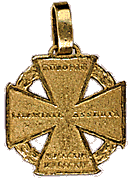 As might be expect in
such a rank conscious country many officers resented having to wear the same medal
as common soldiers. It was for this reason that three sizes had originally been
proposed. Probably based on the golden cross of FM. Schwarzenberg, many officers
had their cross gilded, usually after removing the green varnish. Less often the
cross was recast in gold, or in bronze and heavily gilded. In some cases officers
had their initials or entire name, rank and unit engraved on the ends of the arms.
Suspension was usually a replacement oval gold strap and they vary greatly. All
officer's crosses are scarce and the named ones especially so. As these crosses
were unofficial many collectors take no note of them (or at least pay no premium
for them) while others prize them dearly. Illustrated is a recast and heavily
gilded officers cross with gold strap suspension.
As might be expect in
such a rank conscious country many officers resented having to wear the same medal
as common soldiers. It was for this reason that three sizes had originally been
proposed. Probably based on the golden cross of FM. Schwarzenberg, many officers
had their cross gilded, usually after removing the green varnish. Less often the
cross was recast in gold, or in bronze and heavily gilded. In some cases officers
had their initials or entire name, rank and unit engraved on the ends of the arms.
Suspension was usually a replacement oval gold strap and they vary greatly. All
officer's crosses are scarce and the named ones especially so. As these crosses
were unofficial many collectors take no note of them (or at least pay no premium
for them) while others prize them dearly. Illustrated is a recast and heavily
gilded officers cross with gold strap suspension.
Variations
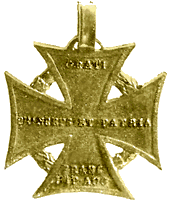 This medal was awarded
to all serving soldiers in the years 1813-1814, and with so many being awarded
several sets of dies (and perhaps several production facilites) were used. I am
unaware of any study having been made of these variations, but I show one here
that was illustrated in Die Befreiungskriege 1813: Festscrift zur Jahrhundertfeier
which was the centennial volume produced by the city of Vienna on the campaigns
covered by this medal. Note the deeply tailed arms, unlike the straight arms of
the normal version. This piece is supposedly from the Army Museum in Vienna. Also
note that original copies have a double eagle hallmark within a diamond on the
top suspension strap. Since the bronze wore away quickly with use it is often
replaced with a plain metal strap and so lacks the hallmark. The green lacquer
applied to the background itself has numerous variations in color and composition.
I have four Canon Crosses with the lacquer intact and all have noticably different
shades of green and pigment types.
This medal was awarded
to all serving soldiers in the years 1813-1814, and with so many being awarded
several sets of dies (and perhaps several production facilites) were used. I am
unaware of any study having been made of these variations, but I show one here
that was illustrated in Die Befreiungskriege 1813: Festscrift zur Jahrhundertfeier
which was the centennial volume produced by the city of Vienna on the campaigns
covered by this medal. Note the deeply tailed arms, unlike the straight arms of
the normal version. This piece is supposedly from the Army Museum in Vienna. Also
note that original copies have a double eagle hallmark within a diamond on the
top suspension strap. Since the bronze wore away quickly with use it is often
replaced with a plain metal strap and so lacks the hallmark. The green lacquer
applied to the background itself has numerous variations in color and composition.
I have four Canon Crosses with the lacquer intact and all have noticably different
shades of green and pigment types.
Civil Honor Cross for 1813-14
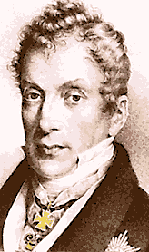
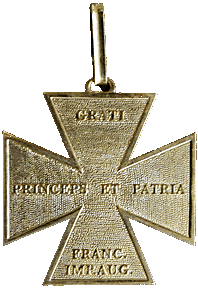 Established by Emperor Francis in 1814 to reward high state officials who distinguished
themselves during the Befreiungskrieg of 1813-14. The award was finalized on 26
May 1815 when it was awarded. The dies were also made by Harnisch and the cross
was issued in gold and silver.The Civil Cross is identical to the Canon Cross
except it lacks the laurel wreath. Only 38 gold and 149 silver crosses were issued,
and Gottschalk lists all recipients. As it is so rare one must be careful to avoid
Canon Crosses without wreaths that have been silver or gold plated.
Established by Emperor Francis in 1814 to reward high state officials who distinguished
themselves during the Befreiungskrieg of 1813-14. The award was finalized on 26
May 1815 when it was awarded. The dies were also made by Harnisch and the cross
was issued in gold and silver.The Civil Cross is identical to the Canon Cross
except it lacks the laurel wreath. Only 38 gold and 149 silver crosses were issued,
and Gottschalk lists all recipients. As it is so rare one must be careful to avoid
Canon Crosses without wreaths that have been silver or gold plated.
As a parallel to the large gold cross of FM. Schwarzenberg, a great gold cross
was given to Prince Metternich, minister of foreign affairs at this time. It too
was to be worn around the neck and is said to have been twice the size of the
other crosses and similar in details to that of FM. Schwarzenberg. It is seen
in prints and paintings of the period but its current location is unknown. It
was likely taken away by Prince Metternich when he fled Vienna during the Revolution
of 1848, but could either have been destroyed in the fire that later burned the
family schloss on the Rhine or it could be in the possession of one of his modern
heirs.On the left is an engraving of Prince Metternich wearing his special
large Civil Honor Cross. On the right is a gilt museum replica of the Metternich
Cross. Note that, as in the engraving, Metternich's Cross has the normal, grooved
ribbon ring and not the elaborate laurel leaf ring as on Schwartzenberg's large
Cross in the Army Museum in Vienna.

Ribbon: Gold/black/gold, the reverse of the Canon Cross.
Size: Accounts are confused, some saying exactly the same 27mm of the Canon
Cross and others 10% larger at 30 mm. Obviously few genuine examples are around
to be measured. Von Falkenstien says both, that it was the same size and also
30 mm!
Gold Cross for the Guard of Bohemian Nobles in 1814
Established by Emperor Francis toward the end of 1814 as a sign of thanks for
the 38 members of the Bohemian nobility who had accompanied him in the field in
1813-14. Of these medals only 22 can be traced and 21 are in museums.

Ribbon: White, red, white stripes of equal width.
Size: 30 mm.
Obverse: A red enamelled gold cross with a center circle containing the
heraldic lion of Bohemia in silver.
Reverse: The cross enamelled red with the central medallion in white enamel
bearing the seven line inscription: "NOBILIBUS BOHEMIS BELLO GALLICA FIDES CORPORIS
CUSTODIBUS FRANCISCUS AUGUSTUS MDCCCXIV".
Military Service Medal "Pro Virtute Militari" of 1816
Although the Coronne de Fer was for military or civil merit this replacement medal
for non-noble members was for military service only. It is very rare since so
few members of the Coronne de Fer were willing to exchange it for this unassuming
(even dull) silver medal. It was issued in silver but is (unofficially) also known
in gold and bronze gilt. Although the Austrian Order of the Iron Crown changed
its ribbon from green and gold to blue and gold, this medal for lesser members
retained the French green and gold ribbon. Suspended through a soldered ring.

Ribbon: Golden yellow with two thinner sides stripes in green.
Size: 37 mm
Obverse: An upright antique sword.
Reverse: Inscription: "PRO / VIRTUTE / MILITARI".
Small Reward Medal "ZUR BELOHNUNG"
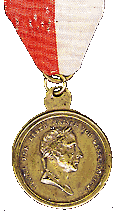 Small reward medal for service to the
Emperor and state. Von Falkenstien says it was issued in silver with a red ribbon,
but I have an example in bronze gilt on an original ribbon of equal red and white
stripes with original stitching intact (illustrated at the left).
Small reward medal for service to the
Emperor and state. Von Falkenstien says it was issued in silver with a red ribbon,
but I have an example in bronze gilt on an original ribbon of equal red and white
stripes with original stitching intact (illustrated at the left).

Ribbon: Red, or possibly red and white.
Size: 22 mm.
Obverse: The laurel crowned Emperors bust in profile facing right. The
circumference inscription reads: "FRANZ DER ERST KAISER VON OESTERREICH".
Reverse: A garland of flowers around the circumference, and in the center,
on two lines: "ZUR / BELOHNUNG".
Bibliography
Gottschalck, F. Almanach der Ritterorden, 3 vols., Leipzig 1817-19.
Contemporary with this period, Gottschalck's book is a goldmine of information
on the ancient orders. Very scarce, although some modern reprints exist.
Gritzner, M., Handbuch der Ritter und Verdienstorden Aller Kulturstaaten der
Welt, Leipzig, 1893.
Michetschlager, H., Das Ordesbuch der gewesenen Österreichisch-Ungarischen
Monarchie, Vienna, 1918-19.
Spada, Antonio, Onori e Glorie, Vol. 3, Brescia, 1983.
One of the finest illustrated books on orders ever produced, this publication
displays Dr. Spada's incomparable collection. Austrian orders and some medals
of the Napoleonic period are well illustrated.
Steiner, Jörg C., Orden und Ehrenzeichen der Österreichisch-Ungarischen
Monarchie, Vienna, 1991.
Not complete and the prices are now out of date, although relative values are
still useful. Nevertheless this is the only current listing of Austrian material
and we can hope for an improved new edition.
von Falkenstien, J., Imperial Austrian Medals and Decorations, Tucson,
1972.
The only thorough discussion and catalog of Austrian medals in English (orders
are not included). Uneven and has many errors but is essential for English readers.
von Hessenthal, W. and Schreiber, G., Die Tragbaren Ehrenzeichen Des Deutschen
Reiches, Berlin, 1940.
von Heyden, H., Ehren-Zeichen der Erlbschenen und Bluhenden Staaten Deutschlands
und Österreich-Ungarns, Meiningen, 1897-1910 editions.
von Rosenfeld, F.H., Die Orden und Ehrenzeichen der K. und K. Österreichisch-Ungarischen
Monarchie, Vienna, 1889 and 1899 editions.
von Wrede, A., K. und K. Wehrmacht, Vienna, 1901.
A complete official history of the K. und K. army. Lists awards of orders and
bravery medals to officers, sometimes with details of service.
Sales Catalogs
Much useful information is also to be found in the auction and sales catalogs
of the better dealers in this material such as those of Graf Klenau and Andreas
Thies. Of particular value is:
The Art of Chivalry: Orden und Ehrenzeichen der Deutschen Befreiungskriege,
Thies and others, Nörtingen, 1991.
Austrtian orders and decorations for sale can often be found at:
Stephen Herold Historical Objects
 Ancient and inherited from the dukes
of Burgundy who founded it on 10 January 1429. Awarded only to the Imperial family
and the highest of the nobility in Austria and abroad. One had to be Catholic
and of good character to receive it. Except for Imperial archdukes and foreign
nobility it was usually only given late in life as a reward for a lifetime of
service to the Imperial family.
Ancient and inherited from the dukes
of Burgundy who founded it on 10 January 1429. Awarded only to the Imperial family
and the highest of the nobility in Austria and abroad. One had to be Catholic
and of good character to receive it. Except for Imperial archdukes and foreign
nobility it was usually only given late in life as a reward for a lifetime of
service to the Imperial family.
 Founded by the Empress Maria
Theresa on 22 June 1757 as a reward for merit for senior military officers. The
order was to be granted as a reward for acts of military valor and to perpetuate
the memory of the brave officers receiving it. An officer had to command in a
battle or a unit in a winning action to be eligible for the higher grades, and
even Oberlieutenants had to perform prodigious feats of duty and valor to receive
the knight's cross. Not often awarded in the Austrian army. As with many high
orders the decoration was to be returned to the Chancellery of the Order on the
death of the holder. This is one reason for its great rarity, especially of older
issues. Almost all known copies in commerce are 20th century, most from the First
World War or insignia made for holders of the Order after the end of the war.
Founded by the Empress Maria
Theresa on 22 June 1757 as a reward for merit for senior military officers. The
order was to be granted as a reward for acts of military valor and to perpetuate
the memory of the brave officers receiving it. An officer had to command in a
battle or a unit in a winning action to be eligible for the higher grades, and
even Oberlieutenants had to perform prodigious feats of duty and valor to receive
the knight's cross. Not often awarded in the Austrian army. As with many high
orders the decoration was to be returned to the Chancellery of the Order on the
death of the holder. This is one reason for its great rarity, especially of older
issues. Almost all known copies in commerce are 20th century, most from the First
World War or insignia made for holders of the Order after the end of the war.
 Established by the Empress
Maria Theresa on 5 May 1764 to reward her noble Hungarian subjects for civil merit.
To receive it one had to have at least four quarterings of arms showing as many
generations of noble status. It helped promote her position as Queen of Hungary
and reinforced the quasi independent position of Hungary in the Empire. The original
statutes allow for only 20 Grand Crosses, 30 Commanders and 50 Knights who are
to be "distinguished for virtue and merit and noble birth". Grand Cross Knights
were considered so important that the Emperor was to address them as "Cousin".
These insignia were to be returned to the Chancellery of the Order on the death
of the holder. There was no military application of this order. It is rare, and
even modern awards of St. Stephen are seldom seen. Perhaps more than any other
Austrian order, this one approached the ideal character as put forth in its statutes
and regulations.
Established by the Empress
Maria Theresa on 5 May 1764 to reward her noble Hungarian subjects for civil merit.
To receive it one had to have at least four quarterings of arms showing as many
generations of noble status. It helped promote her position as Queen of Hungary
and reinforced the quasi independent position of Hungary in the Empire. The original
statutes allow for only 20 Grand Crosses, 30 Commanders and 50 Knights who are
to be "distinguished for virtue and merit and noble birth". Grand Cross Knights
were considered so important that the Emperor was to address them as "Cousin".
These insignia were to be returned to the Chancellery of the Order on the death
of the holder. There was no military application of this order. It is rare, and
even modern awards of St. Stephen are seldom seen. Perhaps more than any other
Austrian order, this one approached the ideal character as put forth in its statutes
and regulations.
 Established by Emperor
Francis I on 8 January 1808 in honor of his father, and to provide the Empire
with an order that could be used to reward noble subjects for service to the Emperor
and the State. The existing senior orders before 1808 were too limited in their
scope to permit rewarding sufficient subjects for their duty. The choice of Leopold
for this order's name is not too strange, since he was Francis' father, but he
is also the most shadowy of the modern emperors with his brief two year reign.
The Knights Grand Cross were also addressed by the Emperor (as Grand Master of
the Order) as "Cousin" as with Grand Cross members of the St. Stephen Order. Collars
and insignia were returnable upon death of the member, the collar to the Grand
Master and the insignia to the Registar.
Established by Emperor
Francis I on 8 January 1808 in honor of his father, and to provide the Empire
with an order that could be used to reward noble subjects for service to the Emperor
and the State. The existing senior orders before 1808 were too limited in their
scope to permit rewarding sufficient subjects for their duty. The choice of Leopold
for this order's name is not too strange, since he was Francis' father, but he
is also the most shadowy of the modern emperors with his brief two year reign.
The Knights Grand Cross were also addressed by the Emperor (as Grand Master of
the Order) as "Cousin" as with Grand Cross members of the St. Stephen Order. Collars
and insignia were returnable upon death of the member, the collar to the Grand
Master and the insignia to the Registar.
 When Austria resumed control
of Northern Italy in 1815 she continued the Coronne de Fer as an Austrian order.
The Austrian order was founded by decree of 1 January 1816. All existing noble
members were eligible, but non-nobile members had to accept the Military Service
Medal "Pro Virtute Militari" (listed below).
When Austria resumed control
of Northern Italy in 1815 she continued the Coronne de Fer as an Austrian order.
The Austrian order was founded by decree of 1 January 1816. All existing noble
members were eligible, but non-nobile members had to accept the Military Service
Medal "Pro Virtute Militari" (listed below).








 Founded by Emperor Francis
in 1797 for those members of the Tyrolian volunteer contingent who served in the
keeping the Tyrol free from the French army. Given in large gold, for highest
officers, gold for officers and silver for soldiers. The large gold are very rare
and the gold ones rare. Suspended from a ribbon through a circular eye. The silver
medal is much commoner than that of 1796 so many more Tyrolians must have responded
to the mobilization call.
Founded by Emperor Francis
in 1797 for those members of the Tyrolian volunteer contingent who served in the
keeping the Tyrol free from the French army. Given in large gold, for highest
officers, gold for officers and silver for soldiers. The large gold are very rare
and the gold ones rare. Suspended from a ribbon through a circular eye. The silver
medal is much commoner than that of 1796 so many more Tyrolians must have responded
to the mobilization call.
 Given to those able bodied
men who answered the national emergency mobilization call of Count Saurau in Lower
Austria. These troops were formed into free corps called Landesstande. The medal
was, on paper, awarded in five types: gold for highest officers, largest silver
for officers, large silver for underofficers, silver for soldiers and black cast
iron for non-combattants. The iron medal has never been seen and the soldier's
silver medal is also unknown and probably not issued. The gold medal, given to
Count Saurau, the Duke of Wurttemburg (as commander of the troops) and high district
and government officials is very rare. Almost all medals known are the largest
and the large silver. Suspended by a ribbon from a circular eye.
Given to those able bodied
men who answered the national emergency mobilization call of Count Saurau in Lower
Austria. These troops were formed into free corps called Landesstande. The medal
was, on paper, awarded in five types: gold for highest officers, largest silver
for officers, large silver for underofficers, silver for soldiers and black cast
iron for non-combattants. The iron medal has never been seen and the soldier's
silver medal is also unknown and probably not issued. The gold medal, given to
Count Saurau, the Duke of Wurttemburg (as commander of the troops) and high district
and government officials is very rare. Almost all medals known are the largest
and the large silver. Suspended by a ribbon from a circular eye.






 Authorized by Emperor
Francis in 1814 for award to his soldiers in memory of their participation in
the Befreiungskrieg of 1813-14 to free Germany and Europe from the domination
of Napoleon. It was not actually awarded until 1815. Usually called the "Canon
Cross" because it was made from captured bronze canon, and sometimes wrongly called
the "Leipzig Cross" after that decisive battle in 1813. It is significant in that
it is the first award given equally to all serving soldiers irrespective of rank.
There originally were plans for three sizes of cross, and some specimens do exist,
but in the end only one type, the small bronze with green varnish background,
was made and distributed. One large gilded cross with a laurel leaf decorated
wearing ring was made for FM. Prince Schwarzenberg as commander in chief, and
it was intended to be worn from a ribbon around the neck. This unique piece is
in the Army Museum in Vienna.
Authorized by Emperor
Francis in 1814 for award to his soldiers in memory of their participation in
the Befreiungskrieg of 1813-14 to free Germany and Europe from the domination
of Napoleon. It was not actually awarded until 1815. Usually called the "Canon
Cross" because it was made from captured bronze canon, and sometimes wrongly called
the "Leipzig Cross" after that decisive battle in 1813. It is significant in that
it is the first award given equally to all serving soldiers irrespective of rank.
There originally were plans for three sizes of cross, and some specimens do exist,
but in the end only one type, the small bronze with green varnish background,
was made and distributed. One large gilded cross with a laurel leaf decorated
wearing ring was made for FM. Prince Schwarzenberg as commander in chief, and
it was intended to be worn from a ribbon around the neck. This unique piece is
in the Army Museum in Vienna.
 As might be expect in
such a rank conscious country many officers resented having to wear the same medal
as common soldiers. It was for this reason that three sizes had originally been
proposed. Probably based on the golden cross of FM. Schwarzenberg, many officers
had their cross gilded, usually after removing the green varnish. Less often the
cross was recast in gold, or in bronze and heavily gilded. In some cases officers
had their initials or entire name, rank and unit engraved on the ends of the arms.
Suspension was usually a replacement oval gold strap and they vary greatly. All
officer's crosses are scarce and the named ones especially so. As these crosses
were unofficial many collectors take no note of them (or at least pay no premium
for them) while others prize them dearly. Illustrated is a recast and heavily
gilded officers cross with gold strap suspension.
As might be expect in
such a rank conscious country many officers resented having to wear the same medal
as common soldiers. It was for this reason that three sizes had originally been
proposed. Probably based on the golden cross of FM. Schwarzenberg, many officers
had their cross gilded, usually after removing the green varnish. Less often the
cross was recast in gold, or in bronze and heavily gilded. In some cases officers
had their initials or entire name, rank and unit engraved on the ends of the arms.
Suspension was usually a replacement oval gold strap and they vary greatly. All
officer's crosses are scarce and the named ones especially so. As these crosses
were unofficial many collectors take no note of them (or at least pay no premium
for them) while others prize them dearly. Illustrated is a recast and heavily
gilded officers cross with gold strap suspension. This medal was awarded
to all serving soldiers in the years 1813-1814, and with so many being awarded
several sets of dies (and perhaps several production facilites) were used. I am
unaware of any study having been made of these variations, but I show one here
that was illustrated in Die Befreiungskriege 1813: Festscrift zur Jahrhundertfeier
which was the centennial volume produced by the city of Vienna on the campaigns
covered by this medal. Note the deeply tailed arms, unlike the straight arms of
the normal version. This piece is supposedly from the Army Museum in Vienna. Also
note that original copies have a double eagle hallmark within a diamond on the
top suspension strap. Since the bronze wore away quickly with use it is often
replaced with a plain metal strap and so lacks the hallmark. The green lacquer
applied to the background itself has numerous variations in color and composition.
I have four Canon Crosses with the lacquer intact and all have noticably different
shades of green and pigment types.
This medal was awarded
to all serving soldiers in the years 1813-1814, and with so many being awarded
several sets of dies (and perhaps several production facilites) were used. I am
unaware of any study having been made of these variations, but I show one here
that was illustrated in Die Befreiungskriege 1813: Festscrift zur Jahrhundertfeier
which was the centennial volume produced by the city of Vienna on the campaigns
covered by this medal. Note the deeply tailed arms, unlike the straight arms of
the normal version. This piece is supposedly from the Army Museum in Vienna. Also
note that original copies have a double eagle hallmark within a diamond on the
top suspension strap. Since the bronze wore away quickly with use it is often
replaced with a plain metal strap and so lacks the hallmark. The green lacquer
applied to the background itself has numerous variations in color and composition.
I have four Canon Crosses with the lacquer intact and all have noticably different
shades of green and pigment types.
 Established by Emperor Francis in 1814 to reward high state officials who distinguished
themselves during the Befreiungskrieg of 1813-14. The award was finalized on 26
May 1815 when it was awarded. The dies were also made by Harnisch and the cross
was issued in gold and silver.The Civil Cross is identical to the Canon Cross
except it lacks the laurel wreath. Only 38 gold and 149 silver crosses were issued,
and Gottschalk lists all recipients. As it is so rare one must be careful to avoid
Canon Crosses without wreaths that have been silver or gold plated.
Established by Emperor Francis in 1814 to reward high state officials who distinguished
themselves during the Befreiungskrieg of 1813-14. The award was finalized on 26
May 1815 when it was awarded. The dies were also made by Harnisch and the cross
was issued in gold and silver.The Civil Cross is identical to the Canon Cross
except it lacks the laurel wreath. Only 38 gold and 149 silver crosses were issued,
and Gottschalk lists all recipients. As it is so rare one must be careful to avoid
Canon Crosses without wreaths that have been silver or gold plated. 


 Small reward medal for service to the
Emperor and state. Von Falkenstien says it was issued in silver with a red ribbon,
but I have an example in bronze gilt on an original ribbon of equal red and white
stripes with original stitching intact (illustrated at the left).
Small reward medal for service to the
Emperor and state. Von Falkenstien says it was issued in silver with a red ribbon,
but I have an example in bronze gilt on an original ribbon of equal red and white
stripes with original stitching intact (illustrated at the left).